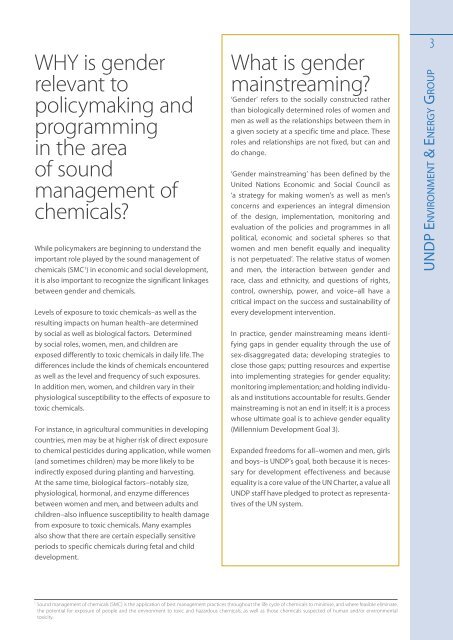Chemicals and gender
Chemicals and gender
Chemicals and gender
Create successful ePaper yourself
Turn your PDF publications into a flip-book with our unique Google optimized e-Paper software.
WHY is <strong>gender</strong><br />
relevant to<br />
policymaking <strong>and</strong><br />
programming<br />
in the area<br />
of sound<br />
management of<br />
chemicals?<br />
While policymakers are beginning to underst<strong>and</strong> the<br />
important role played by the sound management of<br />
chemicals (SMC 1 ) in economic <strong>and</strong> social development,<br />
it is also important to recognize the significant linkages<br />
between <strong>gender</strong> <strong>and</strong> chemicals.<br />
Levels of exposure to toxic chemicals–as well as the<br />
resulting impacts on human health–are determined<br />
by social as well as biological factors. Determined<br />
by social roles, women, men, <strong>and</strong> children are<br />
exposed differently to toxic chemicals in daily life. The<br />
differences include the kinds of chemicals encountered<br />
as well as the level <strong>and</strong> frequency of such exposures.<br />
In addition men, women, <strong>and</strong> children vary in their<br />
physiological susceptibility to the effects of exposure to<br />
toxic chemicals.<br />
For instance, in agricultural communities in developing<br />
countries, men may be at higher risk of direct exposure<br />
to chemical pesticides during application, while women<br />
(<strong>and</strong> sometimes children) may be more likely to be<br />
indirectly exposed during planting <strong>and</strong> harvesting.<br />
At the same time, biological factors–notably size,<br />
physiological, hormonal, <strong>and</strong> enzyme differences<br />
between women <strong>and</strong> men, <strong>and</strong> between adults <strong>and</strong><br />
children–also influence susceptibility to health damage<br />
from exposure to toxic chemicals. Many examples<br />
also show that there are certain especially sensitive<br />
periods to specific chemicals during fetal <strong>and</strong> child<br />
development.<br />
What is <strong>gender</strong><br />
mainstreaming?<br />
‘Gender’ refers to the socially constructed rather<br />
than biologically determined roles of women <strong>and</strong><br />
men as well as the relationships between them in<br />
a given society at a specific time <strong>and</strong> place. These<br />
roles <strong>and</strong> relationships are not fixed, but can <strong>and</strong><br />
do change.<br />
‘Gender mainstreaming’ has been defined by the<br />
United Nations Economic <strong>and</strong> Social Council as<br />
‘a strategy for making women’s as well as men’s<br />
concerns <strong>and</strong> experiences an integral dimension<br />
of the design, implementation, monitoring <strong>and</strong><br />
evaluation of the policies <strong>and</strong> programmes in all<br />
political, economic <strong>and</strong> societal spheres so that<br />
women <strong>and</strong> men benefit equally <strong>and</strong> inequality<br />
is not perpetuated’. The relative status of women<br />
<strong>and</strong> men, the interaction between <strong>gender</strong> <strong>and</strong><br />
race, class <strong>and</strong> ethnicity, <strong>and</strong> questions of rights,<br />
control, ownership, power, <strong>and</strong> voice–all have a<br />
critical impact on the success <strong>and</strong> sustainability of<br />
every development intervention.<br />
In practice, <strong>gender</strong> mainstreaming means identifying<br />
gaps in <strong>gender</strong> equality through the use of<br />
sex-disaggregated data; developing strategies to<br />
close those gaps; putting resources <strong>and</strong> expertise<br />
into implementing strategies for <strong>gender</strong> equality;<br />
monitoring implementation; <strong>and</strong> holding individuals<br />
<strong>and</strong> institutions accountable for results. Gender<br />
mainstreaming is not an end in itself; it is a process<br />
whose ultimate goal is to achieve <strong>gender</strong> equality<br />
(Millennium Development Goal 3).<br />
Exp<strong>and</strong>ed freedoms for all–women <strong>and</strong> men, girls<br />
<strong>and</strong> boys–is UNDP’s goal, both because it is necessary<br />
for development effectiveness <strong>and</strong> because<br />
equality is a core value of the UN Charter, a value all<br />
UNDP staff have pledged to protect as representatives<br />
of the UN system.<br />
1 Sound management of chemicals (SMC) is the application of best management practices throughout the life cycle of chemicals to minimise, <strong>and</strong> where feasible eliminate,<br />
the potential for exposure of people <strong>and</strong> the environment to toxic <strong>and</strong> hazardous chemicals, as well as those chemicals suspected of human <strong>and</strong>/or environmental<br />
toxicity.<br />
3<br />
unDp En v i r o n mE n t & En E r g y gr o u p


